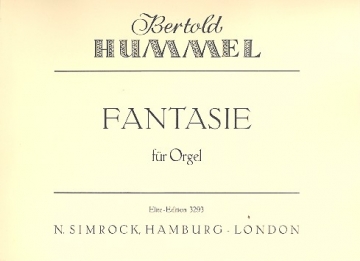Fantasy for Organ, op. 25 (1963)

Introduction
- Passacaglia - Arioso
First performance: July 23, 1963, Freiburg, Freiburger Münster
Dieter
Weiss

Duration: 14 Minutes
Publisher: N. Simrock Hamburg-London (Boosey & Hawkes) ISMN: 9790221112804
| Introduktion | Passacaglia | Arioso |
The Fantasy should be played through without any breaks. The Passacaglia Variations should also merge into each other without delay.
Bertold Hummel
The work was composed for Dieter Weiss, who premiered it on 23 July 1963 in the Münster in Freiburg/Br.
In two large, increasing thrusts, the Introduction
runs up to a powerful tutti, which quotes the first six notes of the
Passacaglia theme in the upper voice (b - a sharp - f sharp - a - g
sharp - e).
The Passacaglia
begins the first movement of its twelve-note theme on it (in the
pedal), while a voice is immediately heard in the manual. The second
variation (manualiter) is played on the Brustwerk with the register
coupling flute 4'. The third variation places the theme on the pedal,
the opposite voice is played on the swell. The strongly rhythmic 4th
variation (theme in G flat) leads over to the more lively 5th
variation, in which the pedal inserts moving figures in a triple rhythm
between the longer theme notes. The 6th variation drives towards the
work's great climax in fast note values, which is reached with calm,
sonorous chords based on the double pedal (in decimal intervals). The
rapid dismantling of the tutti sound concludes with an eight-tone chord
in pianissimo (SW).
This is followed by the particularly melodic Arioso,
a three-part movement throughout (left hand oboe 8' + tremulant in SW).
The two upper voices - on two manuals - again use the thematic material
of the passacaglia theme - above the quasi "piccicato" of the pedal
bass. The work fades away in wonderful calm with the same register with
which it began (BW Gedackt 8').
Dieter Weiss
Larry D. Crummer: The Solo Organ Works by Bertold Hummel, Dissertation 1983
Press
Die Welt, Hamburg,
20th November, 1964
A thoroughly fantastic atmosphere dominates, half visionary with bated breath, half disturbed and excited. This fantasy is the source of the power and fascination of the work.
Fränkisches
Volksblatt, 19th November, 1970
It was a different matter with the central work of the evening, the Fantasy for Organ by Bertold Hummel. The piece provides not only an enrichment and a complement to the German or indeed to the international organ repertoire, but is nothing less than a new discovery. Hummel' style is independent. Even if his Fantasy would have benefited from a larger organ and room from the point of view of sonority, it was nevertheless clear, precisely in this church, how much logic and feel for interrelationships of motifs and themes, how much understanding for attractive effects in rhythm and sonority is contained in Hummel's art. It is in no way a collection of cheap effects or technical games, but the rather the intellectual and musical achievement of an artist who is not only master of his métier in every detail, but also a practising musician who listens to the inner, in his case unerring, voice which dictates inspiration all the way to the tip of the pen. The Fantasy is subdivided into Introduction - Passacaglia and Arioso. Each of these independent parts contains references to a musical germ cell, from which the work grows in an organic unity. Hummel's principle is here remarkable and astonishing. Thus we find a germ cell for example already in the second bar in the bass line of the Introduction. The theme of the Passacaglia is formed out of this, the variants of the Passacaglia undergo intensifications of dynamics and motion, following tonally in the course of the movement the scheme of the circle of fifths. The Arioso makes use in its theme of the intervals of exactly the same germ cell. Polytonality, inversion, crab - these are some more of the features that go to make the work extremely attractive not only as a audible impression but also as an example of compositional technique.
